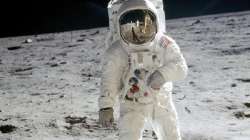Scientists create novel planters for astronauts to grow beans in space
The European Space Agency plans to build a lunar base in 2030 as a stopover on the way to Mars. NASA plans to fly directly to the planet with a target landing date of 2030.

Scientists have created high-tech planters that could allow astronauts to grow beans in space and may also be used to produce more food on the Earth in a sustainable way. Fresh food is so attractive to astronauts that they toasted with salad when they were able to cultivate a few lettuce heads on the International Space Station (ISS) three years ago, researchers said.
"Astronauts like gardening and everything that reminds them of life on earth. They enjoy tending and watering the vegetables, and getting them to germinate," said Silje Wolff, a plant physiologist at the Norwegian University of Science and Technology (NTNU).
The longest stays at the ISS have been six months. People travelling to Mars will need to be prepared to stay in space for at least a year.
The European Space Agency plans to build a lunar base in 2030 as a stopover on the way to Mars. NASA plans to fly directly to the planet with a target landing date of 2030.
"The way space travel works today, it's almost impossible to take along all the resources you need. That's why we have to develop a biological system so astronauts can produce their own food, and recycle all of the resources," said Wolff.
Today's astronauts eat only freeze-dried and vacuum-packed foods.
"Astronauts struggle with having little appetite. They often lose weight. Addressing the psychological aspect of eating something fresh is one of our goals. Vacuum-packed food doesn't really remind you of food. Having something fresh that triggers the appetite and the right receptors in the brain is important," Wolff said.
The new equipment comprises very sophisticated planters that regulate all the water, nutrients, gas and air the plants need.
In space, all the water and food has to be recovered. This means that plant fertilisation needs to be as precise as possible.
Wolff has conducted experiments in climate-regulated growth chambers in the Netherlands as one aspect of this research.
Of all the nutrients plants use, they use nitrogen the most. During her experiments, Wolff looked at different nutrient doses and how they affected the plants' water uptake.
"We found that plants can, in a way, 'smell' the amount of nutrients available to them. When the nitrogen concentration is very low, the plant will absorb more water and thus more nitrogen until it reaches an optimal level," said Wolff.
"The plant has a mechanism that turns on when the nitrogen level is adequate. Then it adjusts both nitrogen and water absorption down," she said.
The next step is to grow beans in space to observe the effect of no gravity on plants' ability to transport water and absorb nutrients. Simulating the absence of gravity can't be done on Earth.
The beans are placed in a centrifuge to sprout and grow in the space station. The centrifuge is rotated to create different amounts of gravity.
"The art of getting something to grow in space can be transferred to our planet," Wolff said.
Food production in cities offers an opportunity to produce more food in the most sustainable way.
Cities do not have much soil for cultivation, but a lot becomes possible if you can plant directly in water in indoor closed systems where all aspects of the climate are regulated.